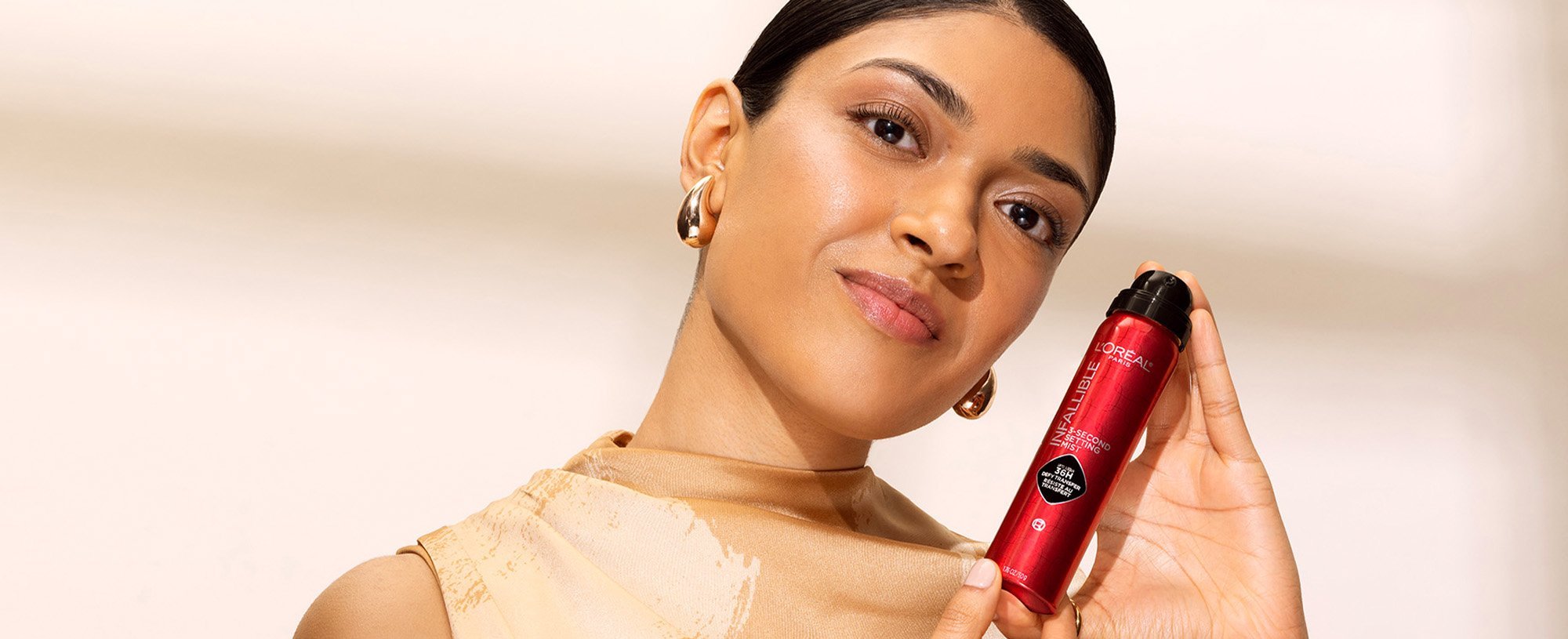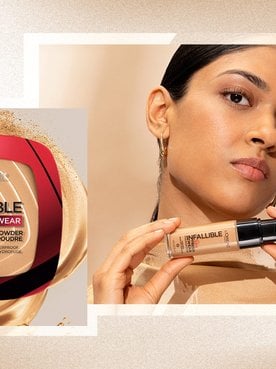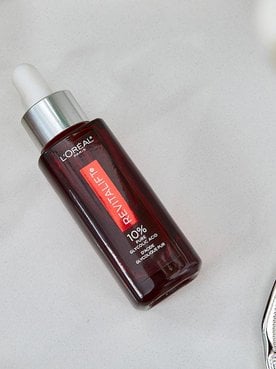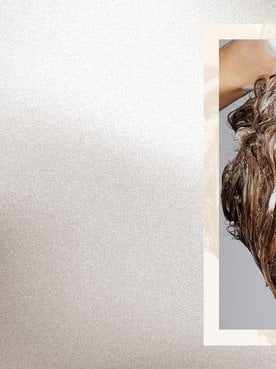If there’s one thing everyone can agree on, it’s that cakey makeup is never a good look. Separation and patchiness can occur for a number of reasons, but typically, it's a result of not applying the products correctly. After you’ve spent your precious time meticulously applying your makeup, the last thing you want to do is have to take it all off and begin again. Thankfully, you don’t have to—there are ways to fix cakey makeup without starting from scratch.
If you’re tired of asking yourself, “Why does my foundation look cakey?” or “Why does my makeup separate?” keep reading. Ahead, we’ll explain what can cause a patchy, uneven makeup application and share our top tips for fixing—and preventing—cakiness. Your path to a flawless makeup application lies ahead.
Why Does My Makeup Look Cakey?
As mentioned above, cakey makeup often results from improper makeup application (applying liquids on top *of powders is one prime example). But that’s not the only thing that can cause your makeup to appear blotchy or uneven. We’re breaking down some of the most common causes of cakey makeup.
1. Dry skin
If your skin is on the drier side (or you’ve skipped skin prep), your skin may feel rough or uneven. Applying makeup on top of this uneven base can, naturally, result in a patchy makeup application. Exfoliating and moisturizing before applying makeup can smooth your skin and help ensure a more even, uniform makeup application.
2. Applying too much product
Piling on thick layer after thick layer of foundation, concealer, and powder, is a recipe for cakiness. It’s like oil painting —the more you add, the more textured it’s going to appear. If you plan to wear a full face of makeup and want to avoid a cakey foundation, apply your products in thin, even layers and let each layer dry and set before proceeding with the next step in your routine.
3. Using incompatible products
You’re probably aware that oil and water don’t mix. The same principle applies to makeup: when layered on top of one another, differing formulas can separate, resulting in a patchy, uneven application. To help avoid cakey makeup, it’s a good idea to double-check that everything you’re using has the same base. Most makeup is either water-based or silicone-based, and a look at the ingredients label should give you a clear idea of which base your product has (silicone-based products typically feature “dimethicone” or another ingredient ending in “-one” as one of the first two or three ingredients; water-based makeup products don’t).
4. Environmental factors
If you’ve prepped your skin well, applied thin layers of product, and chosen complementary formulas, and still find yourself wondering, “Why does my makeup look patchy?” the weather may be to blame. High humidity and extreme heat cause you to sweat more, making your foundation break down and clump together. On the other hand, low humidity and cold weather can cause the skin to dry out and become flaky. Your foundation can then cling to these dry patches, resulting in a cakey, patchy appearance.
4 Tips for Fixing Cakey Makeup
We all make makeup mistakes from time to time. A common question is how to fix cakey makeup. If you end up with cakey makeup, don’t panic, and please don’t break out the makeup remover—instead, try these four tips to help fix your look fast.
1. Spritz your skin with a face mist
Face mists are your number one beauty fix for cakey makeup. It only takes a few seconds to spritz your face, and the moisture can help “melt” your foundation into your skin. When picking a face mist, be sure to choose one with a formula compatible with your makeup (again: water-based if you opted for water-based foundation; silicone-based if you use silicone-based makeup). Be sure to use a light hand when misting your face—you don’t want your face to be wet, just slightly damp.
2. Blend out patchy areas
If your makeup looks patchy, try blending out the uneven areas with a makeup sponge. Start by misting your face to dampen your makeup, then lightly tap the sponge onto your skin to help blend out the uneven areas. If you don’t have a face mist on hand, you can dampen the sponge instead (remember that less is more: it should be slightly damp, not dripping wet).
3. Loosen with steam
Steam can help loosen up stiff, caked-on makeup, making it easier to blend evenly. If you’re finding that some areas appear cakey, consider boiling or microwaving some water and placing your face a foot or so above the steam for a minute. The heat and moisture can help break down the makeup so you can blend it out for a smoother-looking finish.
4. Blot excess oil
Excess oiliness can cause your makeup to separate—which, too, can result in a cakey makeup look. To help prevent separation and minimize shine, reach for blotting sheets. These little papers help absorb excess oil to give your skin a more matte, even appearance. When using blotting sheets, you’ll want to press them onto oily areas, rather than rub—the latter approach can disrupt your base makeup and make it look more uneven.
6 Ways To Avoid Cakey Makeup
Knowing how to fix cakey makeup is useful, but understanding how to prevent patchiness is even better. Here are six things you can do to help ensure a flawless makeup application.
1. Prep your skin
Before applying your makeup, you’ll want to make sure your skin is clean and hydrated—simply moisturizing can go a long way in preventing cakey makeup. Start by washing your face as usual; try ourL’Oréal Paris RevitaLift Radiant Smoothing Cream Cleanser, which gently exfoliates and cleanses your skin.
Then, apply a lightweight, non-greasy moisturizer to hydrate your skin. Try the L’Oréal Paris RevitaLift Micro Hyaluronic Acid + Ceramides Water Cream—it’s water-based, non-greasy, and absorbs quickly, making it perfect for use under makeup.
Once your moisturizer is fully absorbed, layer on a face primer to help provide grip for your base makeup. Our hero product for this is L’Oréal Paris Lumi Glotion Natural Glow Enhancer. This viral TikTok favorite is lightweight. It also works as an illuminating moisturizer and is infused with glycerin and shea butter. It is a luminous primer available in 5 shades to better adapt to the color and undertones of your skin.
2. Choose the right foundation for your skin type
The best makeup for dry skin isn’t necessarily the best for those with oilier complexions, or vice versa. Picking the right makeup for your skin type can go a long way in helping to keep cakiness at bay.
In general, we recommend those with drier skin opt for hydrating yet non-greasy formulas. The L’Oréal Paris Lumi Le Glow Skin Tint is an excellent pick—it’s made with an 82% hydrating serum and leaves the skin looking glowy and fresh. For those who prefer a more skin-like finish, we recommend the L’Oréal Paris True Match Super-Blendable Foundation. The medium-coverage formula is oil-free, non-comedogenic, and provides a seamless, natural-looking finish.

Those with oilier skin, meanwhile, may want to opt for matte foundations. We suggest trying the L’Oréal Paris Infallible Up to 24H Fresh Wear Foundation in a Powder. The weightless formula covers like a liquid but mattifies like a powder without leaving the skin looking patchy or cakey. Bonus: it’s sweat-proof, heat-proof, and waterproof.
3. Use the right tools
An artist is only as good as their tools. How you apply your makeup matters, and the makeup brushes you use can determine whether the result is flawless makeup or cakey makeup. Instead of using your fingers, we recommend reaching for a designated foundation brush or makeup blender for a smooth, non-cakey finish. If you use a dense brush to apply your foundation, that could also be why your makeup looks cakey and heavy. Instead, switch to a stippling brush with less finely packed bristles to create a lighter look.
Once you’ve got your brushes, it’s important that you wash them every couple of weeks to remove makeup buildup, oils, and bacteria. This is not only for hygiene reasons but also to avoid cakey makeup and ensure a more even makeup application.
4. Choose the right concealer
Concealer tends to be a bit thicker and fuller coverage than foundation, which makes it especially prone to settling into fine lines and becoming cakey. If you’re using concealer, we suggest opting for a lightweight, hydrating option, which can help offset dryness and keep cakiness to a minimum. We love the L’Oréal Paris True Match Radiant Serum Concealer, which offers a medium-coverage finish and boasts a hydrating formula that won’t crease or settle into fine lines. Use only as much as you need to camouflage discoloration and blend well to help prevent a cakey makeup application.

5. Use a light hand
As mentioned earlier, using too much product is one of the biggest culprits of cakey makeup. With all of your products, it’s best to use a light hand and build up the coverage as needed. Remember, you can always add more product as needed—but removing product (without starting your look from scratch) isn’t as cut-and-dry.
6. Finish with setting spray
If you’re looking to prevent cakey makeup, setting spray is one of the most useful products to have in your makeup bag. These face mists—sometimes called finishing sprays—help “lock” makeup into place, extending wear and preventing your products from melting, transferring, or moving around. For the best results, look for a formula specifically designed to minimize cakiness, like the L'Oréal Paris Infallible 3-Second Setting Mist. This innovative formula helps extend makeup wear for up to 36 hours and prevents caking, cracking, and flaking for all-day flawless makeup wear.

7. Apply thin layers of product
If you want to avoid cakey makeup, applying products in thin layers is key. Start with a small amount of foundation and build coverage gradually. This ensures a smooth, natural finish without overloading your skin.
Use a damp sponge or a brush to blend the product seamlessly into your skin, pressing gently for a flawless finish. This technique helps avoid streaks and uneven textures, creating a radiant, well-blended look. Remember, less is often more when it comes to achieving a fresh, flawless appearance.
8. Avoid over-powdering
Always be mindful of how much powder you use. Focus on applying powder only where you really need it—typically the T-zone for oily skin. This keeps your complexion looking fresh without adding extra layers. For a seamless finish, you’ll also want to opt for a finely-milled powder, like the L’Oréal Paris Infallible Blur-Fection Longwear Loose Setting Powder, which blurs, brightens, and helps control shine for up to 24 hours.
Before applying, always tap off the excess powder from your brush. This simple step ensures a light, even application and prevents over-powdering, which can lead to a heavy, matte finish. The goal is a smooth, natural look that lets your skin breathe.
Next Up: What's The Difference Between Setting Powder and Setting Spray?
Photo courtesy of L’Oréal Paris







